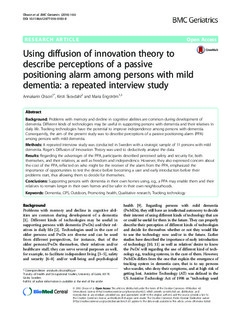| dc.contributor.author | Olsson, Annakarin | |
| dc.contributor.author | Skovdahl, Kirsti | |
| dc.contributor.author | Engström, Maria | |
| dc.date.accessioned | 2017-12-08T11:39:42Z | |
| dc.date.available | 2017-12-08T11:39:42Z | |
| dc.date.created | 2016-08-03T10:09:39Z | |
| dc.date.issued | 2016 | |
| dc.identifier.citation | BMC Geriatrics. 2016, 16 (3), . | nb_NO |
| dc.identifier.issn | 1471-2318 | |
| dc.identifier.uri | http://hdl.handle.net/11250/2469761 | |
| dc.description.abstract | Background Problems with memory and decline in cognitive abilities are common during development of dementia. Different kinds of technologies may be useful in supporting persons with dementia and their relatives in daily life. Tracking technologies have the potential to improve independence among persons with dementia. Consequently, the aim of the present study was to describe perceptions of a passive positioning alarm (PPA) among persons with mild dementia. Methods A repeated interview study was conducted in Sweden with a strategic sample of 11 persons with mild dementia. Roger’s Diffusion of Innovation Theory was used to deductively analyse the data. Results Regarding the advantages of the PPA, participants described perceived safety and security for, both themselves, and their relatives, as well as freedom and independence. However, they also expressed concern about the cost of the PPA, reflected on who might be the receiver of the alarm from the PPA, emphasized the importance of opportunities to test the device before becoming a user and early introduction before their problems start, thus allowing them to decide for themselves. Conclusions Supporting persons with dementia in their own homes using, e.g., a PPA may enable them and their relatives to remain longer in their own homes and be safer in their own neighbourhoods. | nb_NO |
| dc.language.iso | eng | nb_NO |
| dc.relation.uri | http://bmcgeriatr.biomedcentral.com/articles/10.1186/s12877-016-0183-8 | |
| dc.rights | Navngivelse 4.0 Internasjonal | * |
| dc.rights.uri | http://creativecommons.org/licenses/by/4.0/deed.no | * |
| dc.title | Using diffusion of innovation theory to describe perceptions of a passive positioning alarm among persons with mild dementia: A repeated interview study | nb_NO |
| dc.type | Journal article | nb_NO |
| dc.type | Peer reviewed | nb_NO |
| dc.description.version | publishedVersion | nb_NO |
| dc.rights.holder | 2016 Olsson et al. | nb_NO |
| dc.source.pagenumber | 6 | nb_NO |
| dc.source.volume | 16 | nb_NO |
| dc.source.journal | BMC Geriatrics | nb_NO |
| dc.source.issue | 3 | nb_NO |
| dc.identifier.doi | 10.1186/s12877-016-0183-8 | |
| dc.identifier.cristin | 1370202 | |
| cristin.unitcode | 222,56,1,0 | |
| cristin.unitname | Institutt for sykepleie- og helsevitenskap | |
| cristin.ispublished | true | |
| cristin.fulltext | original | |
| cristin.qualitycode | 1 | |

